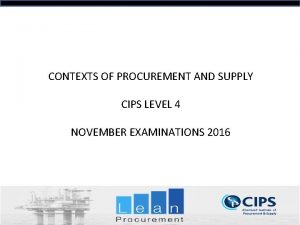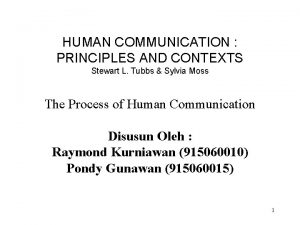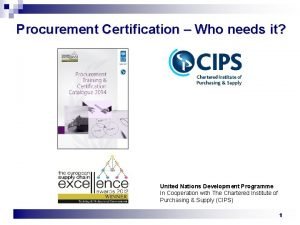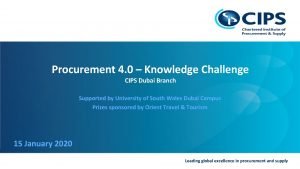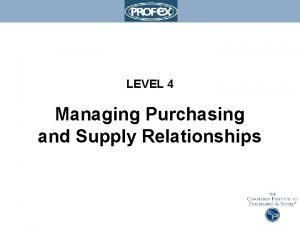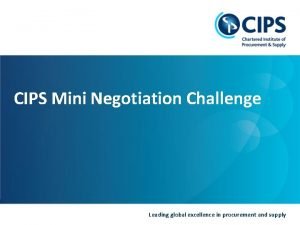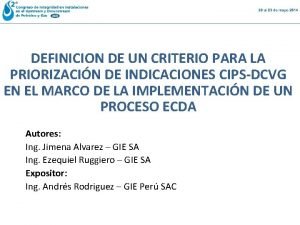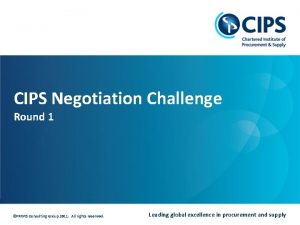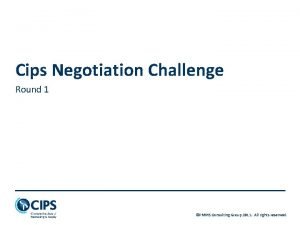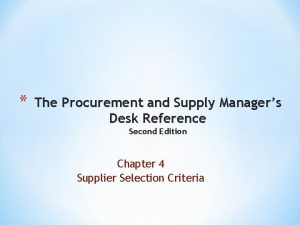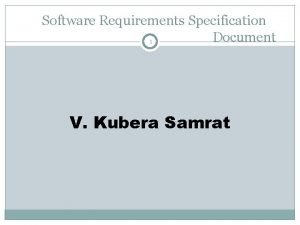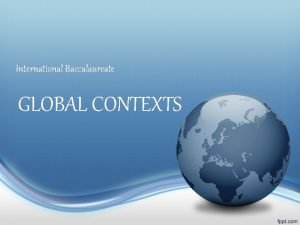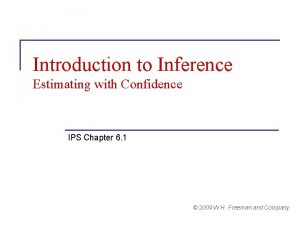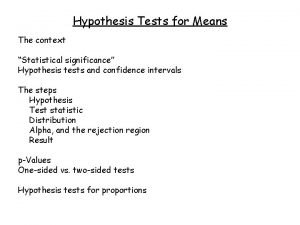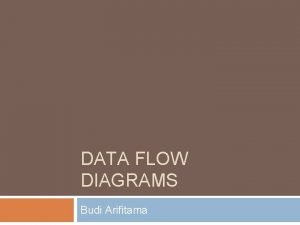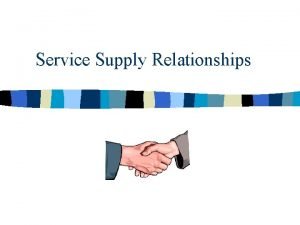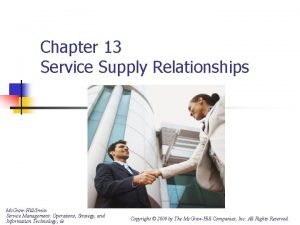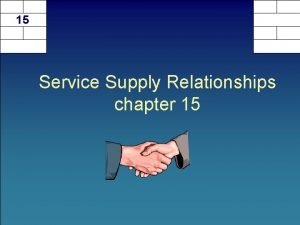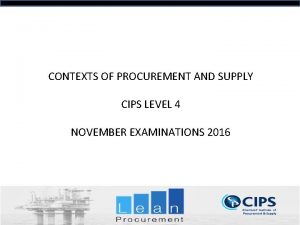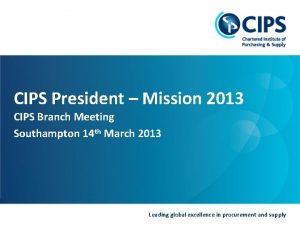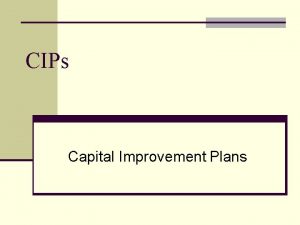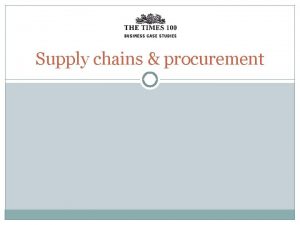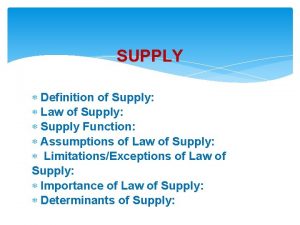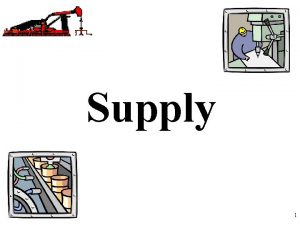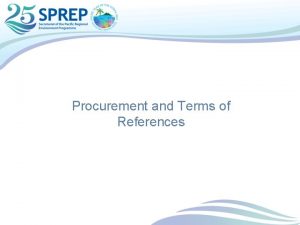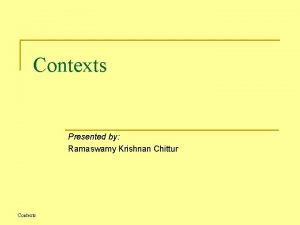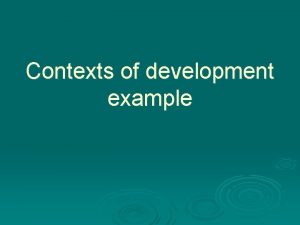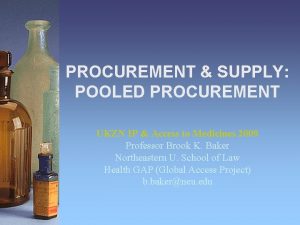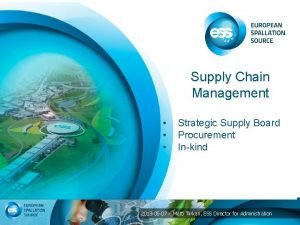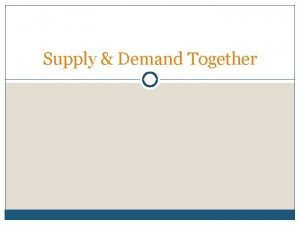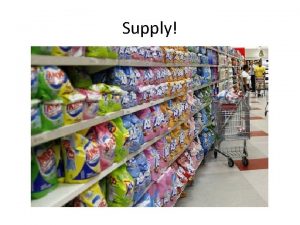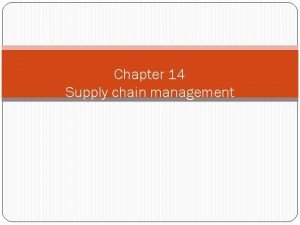CONTEXTS OF PROCUREMENT AND SUPPLY CIPS LEVEL 4






























- Slides: 30

CONTEXTS OF PROCUREMENT AND SUPPLY CIPS LEVEL 4 NOVEMBER EXAMINATIONS 2016

Chapter 8 The Procurement Function in the Organisation Assessment criteria 3. 3 – Compare the different structures of a procurement or supply chain function Headers 1. The procurement or supply chain functions 2. Structuring procurement operations 3. Cross-functional team and project working 4. Outsourcing procurement operations 5. Consortium procurement Introduction § Review of what was discussed earlier along with different ways of structuring proc. § Other areas to consider include x-functional teams, outsourcing and consort proc.

Chapter 8 The Procurement Function in the Organisation Homework A procurement consortium is a group of separate organisations that combine together for the purpose of procuring goods and services. Describe THREE disadvantages, for an organisation, of operating within a procurement Consortium (15 marks) (b) Describe TWO advantages for an organisation in having an outsourced procurement function. (10 marks)

Chapter 8 The Procurement Function in the Organisation 1. The Procurement of Supply Chain Function § Remember that procurement is part of a value chain with the intention to: § Support operations with direct responsibility for logistics § Fulfilling the 5 rights of purchasing § Supports marketing and sales by giving information and knowledge § Also remember that each stage is inter-dependant and should add value Procurement as an internal consultancy or business partner § Consulting – Helps to organise resources and give analysis or suggestions § External consultants – Use expert knowledge with areas like management/ market § Internal consultants – No direct authority and needs to use their influence § Internal consultants – Often used to solve issues when: § There are part time buyers who lack the skills § Procurement is needed for a multi-functional project § Disciplines and skills are needed in other areas § Procurement doesn’t have the formal authority and promote

Chapter 8 The Procurement Function in the Organisation 1. The Procurement of Supply Chain Function Procurement as an internal consultancy or business partner § Other areas where procurement can act as an internal consultancy include: § Establishing procurement policies and procedures § Establishing preferred and approved suppliers lists § Giving purchasing research and information § Establish standard terms and conditions in contracts § Negotiate services and skills § Management of the supplier and supplier relationships § § In some cases other department pay for this internal consultancy Often need to prove their value by presenting data and how they have achieved their initial objective

Chapter 8 The Procurement Function in the Organisation 1. The Procurement of Supply Chain Function Procurement as an internal consultancy or business partner § Some of the challenges of internal consultancy include: § § § The structure, senior management and culture of the organisation Skills, contacts and expertise are required from procurement Clear mechanisms must be in place for getting to the information The need for customer service and value for money outcomes § Procurement needs to focus on the needs of the internal customer § Procurement also has an impact on external customer satisfaction, including: § § § The five rights of purchasing Development of new products The sourcing of peripheral goods and services to the overall package Four stages of procurement development: § § Passive – No real direction, very reactive Independent – Uses better procurement techniques and processes and value measured Supportive – Supports the strategy Integrative – Full integration into the firms overall strategy

Chapter 8 The Procurement Function in the Organisation 2. Structuring procurement operations Factors in structuring procurement Factors can include: § The size, nature and role – tasks, activities, dedicated function § Alignment with corporate structure and strategy – categories, manufacture, etc § Structure and environment – nature of internal customer, perception of role etc § Strategic objectives – cost reduction, responsiveness, quality etc Centralised and devolved structures § Centralised v Decentralised § Can depend on nature of procurement (e. g services tend to be devolved) § Can be argued that a centralised procurement function is better places to deal with areas such as policy, major contract negotiation, processes etc § But this can lead to some difficulties when: § Different divisions need different materials § Strategic business units area scattered across the globe

Chapter 8 The Procurement Function in the Organisation 2. Structuring procurement operations Advantages of centralised purchasing § Specialisation of procurement staff § Potential consolidation of requirements § Better coordination of procurement activities § Better standardisation of specifications § More effective contract of procurement activity § Avoidance of conflict between business divisions § Access to specialist skills, contacts and resources Advantages of decentralised procurement § Better communication and coordination between procurement and operating depts § Customer focus where the buyer is closer to internal and external customers § Quicker response to operational and user needs § Knowledge of and relationships with suppliers § Smaller purchasing quantities § Accountability § Freeing central procurement for higher level, value adding tasks

Chapter 8 The Procurement Function in the Organisation 2. Structuring procurement operations Centralised procurement: a shared services approach § Shared service – a support function to support many different departments § Regional locations still have their autonomy but outsource internally for services § SSU responsible for managing costs, quality and time of its services § Can lead to cost savings and works best when there is standardisation across the business § The shortfalls include: § Can encourage a centralised approach that stifles innovation and initiative § Value and performance levels of SSU’s are not easily monitored § SSU can sacrifice effectiveness over efficiency § Staff in SSU’s can be remote from end users

Chapter 8 The Procurement Function in the Organisation 2. Structuring procurement operations The structure of a centralised procurement of supply chain team § Figure 8. 1 – Organisation of a small procurement department § Structure has little scope for specialisation, big decisions done by buyer § Figure 8. 2 – Organisation of a medium sized procurement department § Chief buyer responsible for procurement policy and management § Daily tasks carried out by the buyers, enough to specialise (commodity, project) § Figure 8. 3 – Organisation of a large procurement department § Communication can become an issue

Chapter 8 The Procurement Function in the Organisation 2. Structuring procurement operations Hybrid Structures § A mix of centralised and decentralised procurement § Table 8. 1 – Typical divisions of roles between local and central procurement functions § Local: § Small order items § Items used only by division § Emergency procurements § Items sourced from local suppliers § Local procurement undertaken for social sustainability reasons § Centralised: § Determination of major procurement and SC policies § Preparation of standard specifications § Negotiation of bulk contracts for number of divisions § Procurement research § Procurement of capital items § Procurement capability development

Chapter 8 The Procurement Function in the Organisation 2. Structuring procurement operations Hybrid Structures § Hybrid examples include: § CLAN (centre led action network) – mostly decentralised o Procurement staff in different business units reporting to BU manager o Role to lead and coordinate network of local buyers o Parts of centralisation, decentralisation and matrix structure used o Advantages include procurement being close to local needs and react but there o is a loss of leverage § SCAN (strategically controlled action network) – mostly centralised o Similar to CLAN but buyers report to head office central procurement unit o Central unit is responsible for policy, strategy, training etc o Become more popular than CLAN in large organisations that want to leverage procurement

Chapter 8 The Procurement Function in the Organisation 2. Structuring procurement operations Hybrid Structures § Hybrid examples include: § Lead Buyer o Lead buyers in each department that usually has another function o User departments closely involved in procurement decisions o Not procurement professionals but require support from policies, procedures, and guidance from central procurement § Business partnering o Member of procurement team works within a user department o Represents the procurement function and liaises with user function

Chapter 8 The Procurement Function in the Organisation 3. Cross functional team and project working Cross functional teams in procurement § § Brings together people form many disciplines with possible different goals X functional working often done in a matrix structure But project teams are set up often to handle each stage of development In a X functional team the procurement professional is often required to: § Provide process knowledge and expertise § Provide content knowledge § Liaise with supply staff § Putting forward the supply management point of view § Reasons for the popularity of this type of team include: § Increased involvement of procurement staff in strategic decisions § Increased adoption of a supply chain philosophy § Best use of ICT and world class systems § Utilisation of global markets and technologies § The need to leverage HR capability

Chapter 8 The Procurement Function in the Organisation 3. Cross functional team and project working Cross functional teams in procurement Advantages include: § Increase team awareness of other disciplines § Wider pool of viewpoints, expertise and resources § Problem solving § Better control or workflow § Innovation Difficulties include: § Added complexity, conflict and need for a consensus § Lack of clear lines of authority § Time it takes for the team to develop § Practical issues such as organising meetings and information flows

Chapter 8 The Procurement Function in the Organisation 3. Cross functional team and project working Rapport § The sense of relationship or connection when we relate to another person § A good rapport includes being happy and comfortable to talk and being with them § A core skill for influencing, is also: § Helps establish trust and belief there is a common ground § The basis of the positive influencing approach § Creates a reason for people to agree with you § Overcomes some barriers created by power imbalances § Rapport building techniques include: § Mirroring the other persons posture § Picking up on the other persons technical words and ways of expression § Listening attentively and engaging with the other person § Finding topics of common interest § Remembering and using people’s names

Chapter 8 The Procurement Function in the Organisation 4. Outsourcing procurement operations What and when to outsource Table 8. 2 – When procurement can be outsourced: § When procurement is a bolt on to the main activities of the business § The supply base is small, established with no supply restrictions § The supply base in small, non-strategic, non-critical and low risk items Benefits and challenges to outsourcing procurement Benefits include: Freeing up resources Harness skills, experience and expertise of another supplier that is higher than yours Potential for aggregation

Chapter 8 The Procurement Function in the Organisation 4. Outsourcing procurement operations What and when to outsource Table 8. 2 – When procurement can be outsourced: § § § When procurement is a bolt on to the main activities of the business The supply base is small, established with no supply restrictions The supply base in small, non-strategic, non-critical and low risk items Benefits and challenges to outsourcing procurement Benefits include: § § § Freeing up resources Harness skills, experience and expertise of another supplier that is higher than yours Potential for aggregation Focus purchasing staff on strategic issues Better flexibility for changes in activity Drawbacks include: - § Potential to lose critical skills and knowledge base § Potential to lose control § Creates and additional management layer

Chapter 8 The Procurement Function in the Organisation 5. Consortium Procurement § § § A combination of a group of separate organisations for procurement Leverages their demand created a higher level of buying power Led by a centralised of shared procurement unit Usually done over a short period of time as difficult to form relationship with so many Can be found in both public and private sectors Benefits § § § Higher level of bargaining power Ability to create framework agreements Members can pool expertise, knowledge and contacts Drawbacks § § § Costs and effort required for communication and coordination Transparency required between members Long negotiation and decision process Large contracts may disadvantage smaller suppliers Members may not purchase to agreed specification Potential with laws and regulation to stop dominant consortia abusing market position

Chapter 9 – ICT Systems Assessment Criteria o 3. 4 Explain the common IT systems that can be used by a procurement or supply chain function Headings 1. The broader impact of ICT on procurement and supply chain management 2. Inventory management systems 3. Enterprise resource planning (ERP) 4. Communication systems

Chapter 9 – ICT Systems 1. The broader impact of ICT on procurement and SC management Benefits of ICT include: § Automation and computerisation raises productivity § Technology opens up new product markets § Technology opens up new supply markets § Technology change business processes § Production processes § Supply and distribution processes § Technology changes the amount of labour and types of skills required by business

Chapter 9 – ICT Systems 1. The broader impact of ICT on procurement and SC management Similar to content in Chapter 6. Impact ICT has on procurement in particular: § Increases the speed of communication and information processes § Offers wider access to environmental and supply market information § Offer 24/7 global business § Supports paperless communication § Offers opportunities for cost savings § Frees up buyers time for higher level tasks § Offers better management information § Creates a virtual supplier relationship, team and organisation Can also help relationships by: § Giving real-time information for transactional processes, delivery and VA activities § Streamlining procurement and delivery processes § Supporting the customisation of products and services § Creating knowledge communities and facilitating coordination of activities

Chapter 9 – ICT Systems 2. Inventory management systems Activities include: § Demand management § Forecasting demand § Controlling stock levels § Suppliers are re-stocked in line with company policies § Developing cost effective systems and procedures for ordering § Controlling the receipt, inspection, storage and issue of supplies § Ensuring stocks are safe and secure from deterioration, damage and theft

Chapter 9 – ICT Systems 2. Inventory management systems Data capture for stock tracking § EPOS systems and RFID for data capture Barcodes Used for: § § Transmitting information to the inventory systems Tracking deliveries in transit Recording issues of items from stock Recording outgoing deliveries RFID § § § Captures goods inward information accurately Records stock movements Maintains stock balances Can trigger automatic replenishment More on Page 184

Chapter 9 – ICT Systems 2. Inventory management systems Warehouse Management Systems § With integration into warehouse and distribution systems, functions can include: § Changes to layout design § Processes created to support prioritisation of material flow § Controlling automated goods vehicles § Vehicle tracking § Transport planning § Direct input of information to HM Customs and Excise systems

Chapter 9 – ICT Systems 3. Enterprise resource planning (ERP) Management Information Systems § The collating, processing and formatting of data § Tools include: § Databases and database management systems § Decision support systems (e. g. Exel) § Management information systems (integrated systems, e. g SAP) § Often information is all over the place in most companies, MIS tried to connect MRP §Procedures, decision rules and records using information from BOM, inv and lead times §Production schedule obtained from sales forecast, actual sales data and orders §System then looks at the BOM and see what stock levels there are §Often automatic PO’s created and take into account lead times

Chapter 9 – ICT Systems 3. Enterprise resource planning (ERP) MRP §MRP process on Figure 9. 1 Page 186 §Whole process can potentially be automated §It is essential to have good quality data and full BOM to work §Close supplier management is also important APS § Usually a module within MRP and ERP systems § Automatically gathers and analyses data from many areas of the business ERP § Integrates many of the organisational areas of the business electronically (e. g SAP) § ERP 1 looks at operations only, ERP 2 looks at the whole organisation § Integrates many areas of the business, better communication and info access § Many large companies have a very sophisticated ERP system, e. g Tesco

Chapter 9 – ICT Systems 4. Communication systems EDI § Provides a low level of information sharing § Information is shared on an agreed structure externally between buyer and supplier § Internet has greatly advanced primitive EDI via networks and protocols Intranets § A private network only giving users access via security levels § Can be used in internal supply chains § Supports two way data sharing and gives employees wider access to information Extranets § Similar to intranet but with access for external users, e. g. CIPS website § Good for relationship management; e-auctions, tenders, P 2 P etc § Gives suppliers real time access to inventory and demand information

Chapter 9 – ICT Systems 4. Communication systems Extranets § Benefits include: § Supply chain integration § Reduction of operational costs § Improved collaboration and relationship potential § Suppliers able to directly access authorised business information QQ – What could be the downsides of extranets? Virtual team-working and supply chain relationships § Think of the office you’re sitting in just now but it is online. Activities include: § Sharing information § Make joint decisions § Have the same benefits of working in an office

Chapter 9 – ICT Systems 4. Communication systems Mobile telecommunication Benefits include: § § § Ability to do business activities outside an office Access to key contacts Ability to carry out e-commerce The internet and e-commerce Can be used for: § § Marketing Direct distribution Customer service and technical support Partnership development Benefits include: § Wider choice of suppliers § Savings in procurement costs § Support for low inventory and good stock turnover § Improved supply chain relationships
 Cips procurement process
Cips procurement process Cips code of ethics and professional conduct
Cips code of ethics and professional conduct Shape matching and object recognition using shape contexts
Shape matching and object recognition using shape contexts Tubbs and moss communication model
Tubbs and moss communication model Bolongie
Bolongie Undp full form
Undp full form Cips dubai
Cips dubai Co-destiny relationship
Co-destiny relationship Cips challenge
Cips challenge Cips dcvg
Cips dcvg Pmms consulting
Pmms consulting Cips challenge
Cips challenge Rcog cips
Rcog cips The procurement and supply manager's desk reference
The procurement and supply manager's desk reference What is professional context
What is professional context Writing in academic contexts
Writing in academic contexts Teachers in crisis contexts
Teachers in crisis contexts The sociological perspective stresses that:
The sociological perspective stresses that: Characteristics of bad srs document
Characteristics of bad srs document Global context orientation in space and time
Global context orientation in space and time Intercultural communication in contexts
Intercultural communication in contexts Chapter 5 section 1 supply
Chapter 5 section 1 supply Matching supply with demand
Matching supply with demand Uri ng elastisidad ng supply na may parehong bahagdan
Uri ng elastisidad ng supply na may parehong bahagdan Confidence level and significance level
Confidence level and significance level What is the interpretation of a 96 confidence level
What is the interpretation of a 96 confidence level Confidence level and significance level
Confidence level and significance level Level o dfd
Level o dfd Two-level bidirectional service supply relationship
Two-level bidirectional service supply relationship Customer supplier duality
Customer supplier duality Single-level bidirectional service supply relationship
Single-level bidirectional service supply relationship
